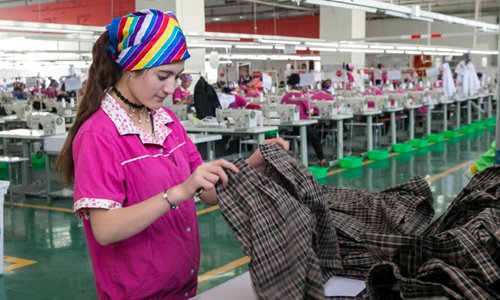HOME >> BUSINESS
Xinjiang’s development will leave vilifiers shamefaced
By Wang Jiamei Source:Global Times Published: 2019/10/23 21:40:28

Photo:Xinhua
As large-scale labor-intensive industries begin to form in Northwest China's Xinjiang Uyghur Autonomous Region, thousands of young people and women are going into the factories through government poverty alleviation projects, a development indicating that the rise of China's western region is set to enter a new stage.
The autonomous region, where GDP growth was once one of the slowest in China, is now on the fast track. Most notably, Xinjiang is expected to become a more important part of the "Made in China" value chain, which will allow it to benefit more from the preferential policies of the central government.
The West and some anti-China forces often smear China's Xinjiang policy, but facts speak louder than words. Xinjiang's unique location and preferential policies have attracted a large number of enterprises. That trend has helped a lot in facilitating the transformation and upgrading of local manufacturing industries.
In 2018, profits made by Xinjiang's large industrial enterprises grew 10 percent year-on-year, while the added value of strategic emerging industries rose by 13.2 percent and high-tech manufacturing soared by 33 percent, according to the government work report for Xinjiang.
In East Asia as well as China's coastal and inland areas, it's common to see manufacturing help to upgrade the economic development model for a country or a region, and now it's time for Xinjiang to follow that path.
As with China's coastal Jiangsu, Zhejiang and Guangdong provinces, farmers, housewives and small shopkeepers in Xinjiang are becoming workers, taking their first step toward modernity.
In the first nine months of this year, Xinjiang added 466,700 urban jobs, up 2.62 percent year-on-year, completing its annual task ahead of schedule, according to data from the region's human resources and social security department. Moreover, nearly 2.58 million surplus rural workers were transferred to employment in Xinjiang from January to September, completing more than 95 percent of its annual target. The new development marks not only the progress of a working model, but also the progress of ideas and lifestyles. Fundamentally, it is the first step by Xinjiang's people to improve their living standards.
After all, it is the top priority for the regional government to protect the rights to life, health and development of the various ethnic groups in the region. And developing labor-intensive manufacturing industries in the region is a crucial step toward boosting the local economy and creating more jobs at this stage.
If they just follow the model for a few more years, people in Xinjiang will see their living standards rise to the national average, which may even be higher than in some other provincial-level regions.
That moment will be a miracle in China and the world. With the rise of its manufacturing, Xinjiang, a region that is home to a large population of Muslim people, is likely to offer the Islamic world a development model. Rumors about China's crackdown on freedom of religious belief and violation of human rights in Xinjiang are doomed to be smashed in the face of reality.
The author is a reporter with the Global Times. bizopinion@globaltimes.com.cn
Posted in: EYE ON ECONOMY